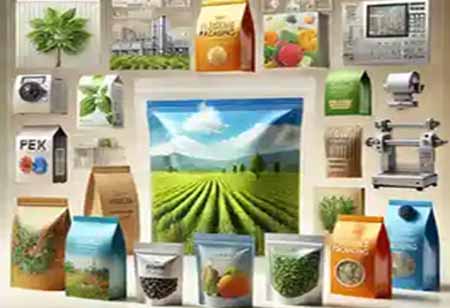Thank you for Subscribing to Environmental Business Review Weekly Brief
Packaging Evolution: Balancing Innovation and Eco-Friendliness

By
Environmental Business Review | Tuesday, April 01, 2025
Stay ahead of the industry with exclusive feature stories on the top companies, expert insights and the latest news delivered straight to your inbox. Subscribe today.
The flexible packaging industry is experiencing a notable transformation, influenced by shifts in consumer behavior, technological advancements, and an increasing focus on sustainability. Organizations across various sectors, including food and beverage, pharmaceuticals, and personal care, are increasingly turning to flexible packaging for its cost-effectiveness, durability, and versatility. The rise in regulatory scrutiny and changing environmental expectations drive the industry toward sustainable practices. Companies prioritizing innovation and adapting to these evolving market trends are setting new benchmarks for packaging efficiency, functionality, and environmental responsibility.
Consumer Demands and Market Trends Redefining Packaging
Convenience needs have vastly reshaped packaging orientation. Lightweight, resealable, and easy-to-handle packaging options are much more desirable for consumers; these features enhance portability and minimize waste. Stand-up pouches, vacuum-sealed bags, and single-serve packaging have now become integral to packaging food, beverage, and pharmaceutical products, extending product shelf life while enhancing the user experience.
The growth of e-commerce has refined the demand for durable and flexible packaging that may remain light on material usage during transit. Online retailers are now finding a balance between ecosystem friendliness and product protection. Brands are adopting digital printing to appeal to customers through personalized designs that are rapidly produced. QR codes and augmented reality features are also rising, allowing consumers to interact with their packaging to learn product information, validate authenticity, and gain promotions.
Yet another salient trend is the move toward minimalism in packaging. Brands resort to simplifying packaging by reducing stacks of useless layers and clear and clean labeling. This improves their recyclability and aligns with the consumers' preference for transparent and authentic branding.
Sustainability and Regulations Driving Material Innovations
Sustainability has become an essential factor in the decision-making process for packaging design. Less plastic waste, lesser carbon footprints, and promotion of a circular economy characterize the solutions demanded by consumers and regulators if not environmentalists. Brands and manufacturers are investing in eco-friendly materials, biodegradable films, paper-based laminates, and recyclable mono-material packaging.
Governments across continents are beginning to formulate more rigorous legislation packages that are prompting corporations to rethink their choice of materials and embrace sustainable practices. The Extended Producer Responsibility Law (EPR) is rapidly gaining traction, holding manufacturers accountable for managing end-of-life packaging materials. Bans on single-use plastics and mandatory recycling are cropping up in many countries, forcing rapid packaging development advancement.
Top sustainable packaging firms are intensifying efforts to develop new materials for plant-based polymers, water-soluble packaging, and compostable bioplastics that present viable alternatives to conventional plastic packaging. This will lessen the environmental load and enhance companies' position in the marketplace, making them more appealing to eco-conscious consumers.
Beyond the input of material innovation, life cycle appraisals are being implemented within companies to assess the environmental footprint of packaging decisions. Increasingly, such organizations are setting ambitious sustainability targets that include the commitment to recyclable or compostable packaging through specific target years. Additionally, the rise in partnerships between packaging producers, retailers, and waste management companies facilitates a smooth and rapid transition toward sustainability.
Challenges and Future Scope of Flexible Packaging
While flexible packaging offers several benefits, the sector must constantly innovate and strategically adapt to challenges. One major challenge is the difficulty of recycling multi-layer flexible packaging. Many flexible package designs use multiple materials for strength, moisture resistance, and barrier protection, but these layers make separation and recycling more difficult.
Manufacturers are beginning to invest heavily in mono-material packaging to improve their recyclability while achieving their necessary functional properties. Innovative solvent-based and chemical recycling methods are being developed to break down these complex materials, improving the circularity of flexible packaging.
Supply chain disruptions and raw material pricing could be significant concerns for the industry. The fluctuation in resin and polymer pricing and logistics issues pressure packaging manufacturers to enhance production and seek alternatives. The improved waste elimination and supply chain agility achieved by digital manufacturing and on-demand productions ensure that companies address these challenges.
The remaining influences on the future of flexible packaging will include the appearance of innovative packaging technologies on the market. Innovations like freshness indicators, temperature-sensitive inks, and RFID-enabled packaging enhance product safety, traceability, and consumer engagement. These innovative solutions help brands manage their inventory better, limit food waste, and provide their consumers with real-time product quality and authenticity information.
The flexible packaging industry will continue to evolve as sustainability, technology, and regulatory compliance take center stage. Companies that invest in greener solutions, leverage digital advancements, and align with consumer expectations will drive the next wave of transformation in the industry.





